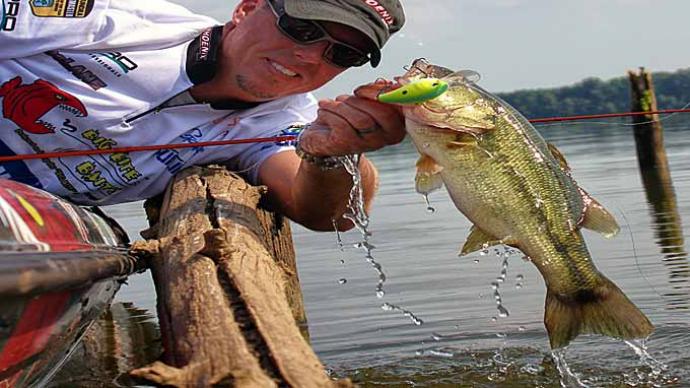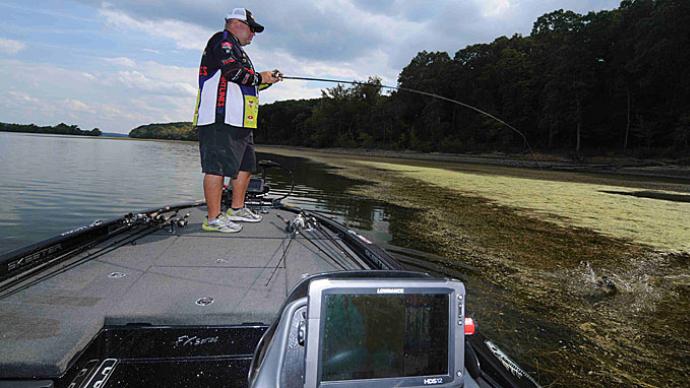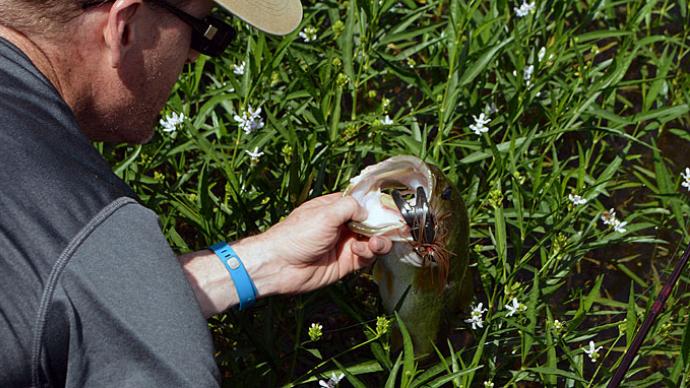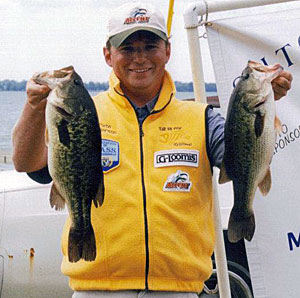
New York’s Finger Lakes, which stretch north and south between Rochester and Syracuse, started as small river valleys widened and deepened by glaciers about 2 million years ago. The longest — a shade more than 38 miles — is Cayuga Lake. Most of it is deep — up to 435 feet — clear and lacks a littoral zone. It’s home to a year-round trout and salmon fishery. It harbors some excellent bass fishing, too.
Heading north from the small lakeside community of Union Springs to where Cayuga Lake empties into the Seneca River is a giant flat. It’s no more than 30 feet deep and covered with submerged grass from shore to shore. A portion of it is where Louisiana angler Greg Hackney won a Bassmaster Elite Series tournament in 2014, one stop on his way to being crowned Angler of the Year. And it's played a role again every time the series returns.
Regardless of where it grows, Aquatic vegetation is a boon to bass fishing. It would be difficult to find an angler who disagrees. While emergent grass offers excellent fishing in spring and summer, submerged beds produce bass year-round. Even when bass flood the banks to spawn, submerged grass beds hold others waiting to spawn and more that have retreated there for recovery. It takes effort to find submerged grass beds and understand the particularities of each, but your work will be rewarded with plenty of bass, both largemouth, and smallmouth. Here’s how to find and fish them.
Where to look
Aquatic vegetation can be divided into two basic types. Emergent grass grows out of the water, and standard varieties include water willow, reeds, and tulles. Submerged grasses grow below or right to the water’s surface. Some of the best-known types are milfoil, coontail, and hydrilla.
Emergent vegetation is almost always found in shallow water, about 5 feet or less. Submerged grasses can grow from the bank out to 20 feet or more. That deeper limit is determined by one lake characteristic: water clarity. Like its land-based cousins, aquatic vegetation needs sunlight to survive. It uses its chlorophyll to produce food through the process of photosynthesis. As long as it has light, submerged vegetation is free to grow anywhere in lakes and reservoirs, especially those with bottoms composed of silt. Its range is usually more limited in rivers, where the current keeps it along the bank or backwaters.
Submerged grass in clear water is pretty easy to find. It’s often just a matter of scanning the water around your boat. You’ll invest more time searching for it on lakes with stained water or where it grows deeper. That might include idling, running around while watching your electronics, or casting a fast-moving diving lure, such as a crankbait, until you snag some. Changes in waves can reveal shallower beds on windy days. You will reduce the area you need to investigate by considering the depth and water clarity.
What you want to see

Once you find a submerged bed, idle or fish around it, that will help you discover its size, depth, and, most importantly, any irregularities. Like other forms of structure and cover, bass gravitate to the parts that are different. You hardly catch bass along a straight river ledge. They are more often grouped on the points, rocks, or brush piles along it. It’s the same with a submerged grass bed. The easiest irregularities to find are around a bed’s edge. Make more casts at any points or pockets you find there. Sometimes bass, especially smallmouth, will hold where the grass forms a sharp, clean break. Don’t pass places where a different type of cover, such as a dock or line of cypress trees, intersects the edge of a submerged grass bed.
There are plenty of bass to catch around the outside of a grass bed, but often you’ll find more buried inside one. From above, beds look like a solid mass of vegetation that no lure or bass can penetrate. But you only see the canopy. Visualize a walk in the woods. You can freely move around the tree trunks, but when you look up, you see a thick canopy. It’s a similar view for bass. They have plenty of room to swim under that canopy. An alternate way of looking at a submerged grass bed is as a mat. When you flip a mat, you punch your lure to the spaces below. It’s the same thing here but with a few feet of open water between you and the mat.
There’s a lot to uncover under the canopy. Rocks, sand, ledges, and even springs can attract bass. Finding those hot spots can be a challenging task. Your electronics can’t peer through the canopy, most times. Usually, it just takes a lot of probing with a heavy jig or Texas-rigged soft-plastic lure to uncover hidden bass-attracting gems. But that doesn’t mean you shouldn’t try. Finding that one special place can mean uncovering a large school of bass.
While getting your electronics to see into submerged grass beds might be difficult, you’ll want to take advantage of their GPS mapping. Drop a waypoint anytime you catch bass. As you add more catches, patterns will emerge. Pay special attention to where waypoints are grouped. They can reveal the location of a bottom change, such as a slight rise or rock pile, that attracts bass. You can use tracks to outline the bed, too.
If the bed is big enough and the wind strong, it can pay to deploy a drift sock. That will slow your boat’s drift, giving you more time to explore.
Fish it fast
Bass that hold in submerged vegetation are no different than those in emergent vegetation. They will chase fast-moving lures that draw reaction strikes. To make that happen, you have to consider two directions. You need the right angle on your retrieve and must ensure your lure is getting down to them. Crankbaits, jerkbaits, and spinnerbaits accomplish both. Regardless of what you tie on, you want to get it hung in the grass and then pop it free. That tussle is an added attraction that excites bass.
Crankbaits are perfect for this pattern. Select one that runs slightly deeper than the top of the grass. If it grows within 3 feet of the surface, use a crankbait that dives 5 feet. And as you slide off the side of the main bed, use progressively deeper-diving plugs to reach the scattered grass that struggles to grow where light levels are lower. There’s no need to bury it deep into the grass. You want your crankbait to get stuck in the top. The commotion will draw them to the lure if the bass are holding deeper in the grass.
Braided line is an essential part of this technique. It has zero stretch, so your lure moves as soon as you move the rod or reel handle. That’s key for generating the force needed to clear your lure from the grass. Use a short fluorocarbon or mono leader — attached to your main line with an Alberto or double-uni knot — if you’re concerned about water clarity. You also will want to step up to a slightly faster-action rod and gear-ratio reel than what’s typically used to throw crankbaits. The rod will help you pop the lure free, and the reel will quickly pick up the slack you create. Many strikes occur on the pause right after your lure clears the grass.
Overcast and windy conditions are best for quickly fishing submerged grass because the low-light conditions make the bass more active. When the sun comes out, and the lake’s surface turns slick, bass will retreat into the grass, and you’ll need to send your lure in after them.
Fish it slow
The veterans called it “dipping” when I started fishing tournaments more than 20 years ago. It’s known as flipping and pitching today. The slow and thorough attack can be a daunting choice when faced with acres of submerged grass to fish, but dropping a Texas-rigged soft-plastic lure or jig and trailer into the grass is a great way to catch bass. It may take a lot of time to find them, but when you do, you can put a bunch in the boat in short order, sometimes on subsequent presentations.
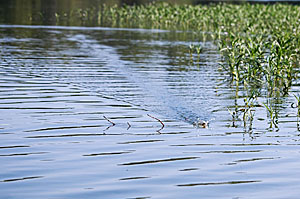
Don’t be timid when selecting a lure. More times than not, you’ll be better off with a bigger one. Bass in submerged grass beds run bigger than average, so they aren’t afraid of larger lures. Plastic worms 7 to 10 inches long, bulky creature baits, and ½- to 1-ounce jigs sporting large chunks are great options. Throw them on flipping sticks with high-speed reels and braided line. Once you set the hook, the combination will help you pull bass up through the grass.
Having heavier lures helps, too. You need to bust through the canopy. If you aren’t using enough weight, your lure can stop at the top of the grass above the bass. The extra weight also helps telegraph bottom composition, making it easier to decipher between mud and rock. That’s an example of a clue you can use to locate bass in large grass beds.
Where you pitch, your lure is not as important. Pitch it into larger holes, but don’t hesitate to drop it into smaller ones or force it into places where there doesn’t seem to be one. Remember, the bass are more concerned with what’s under the canopy.
If bass are positioned high in the grass but want a slower presentation, letting a weightless soft-plastic lure settle can be the ticket. Stick worms, such as a Senko, rigged Texas, or wacky style, are perfect. Let them fall into the grass and slowly work them back out with soft twitches. Sometimes a light shakey head will work here, too.


